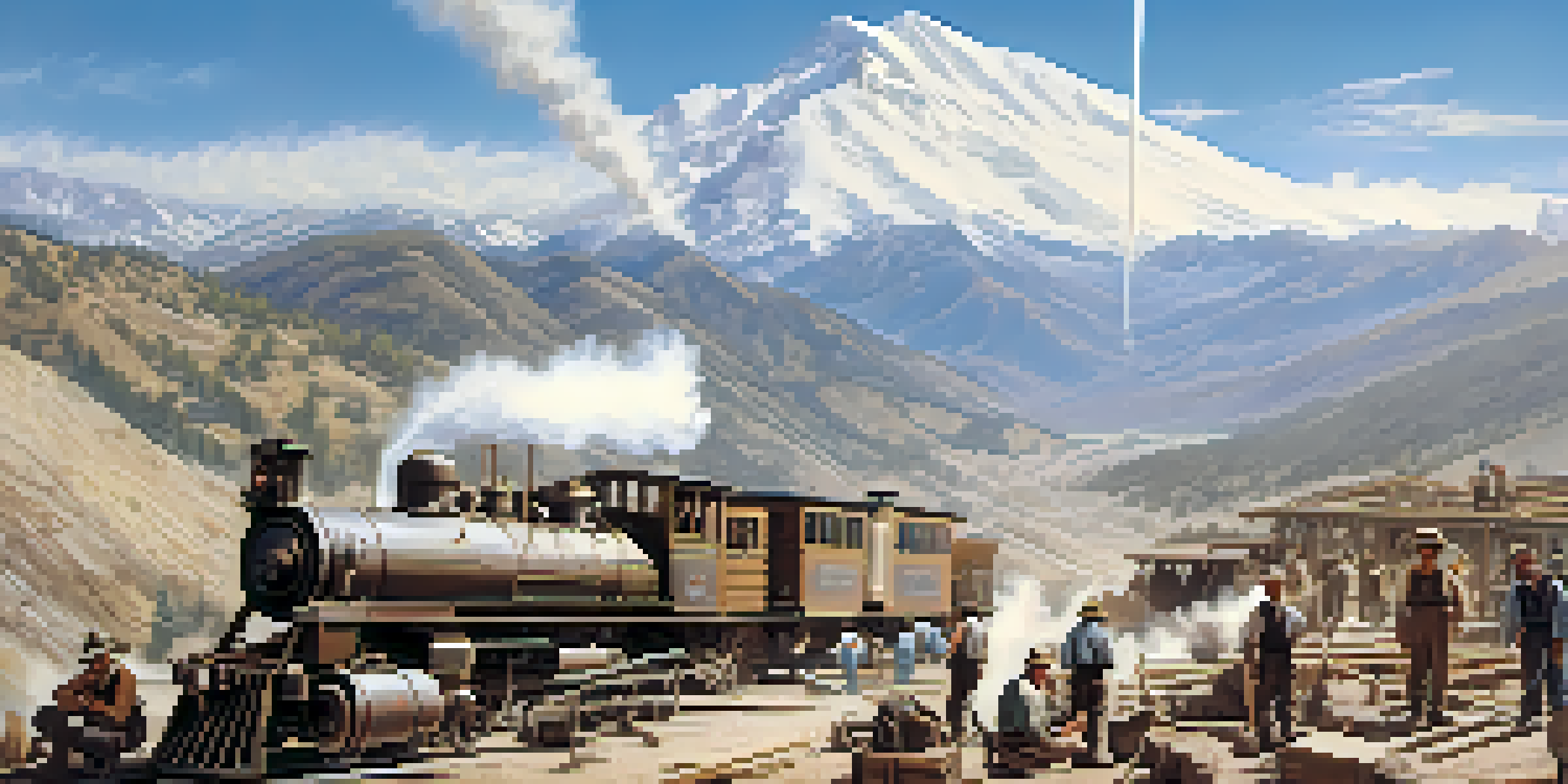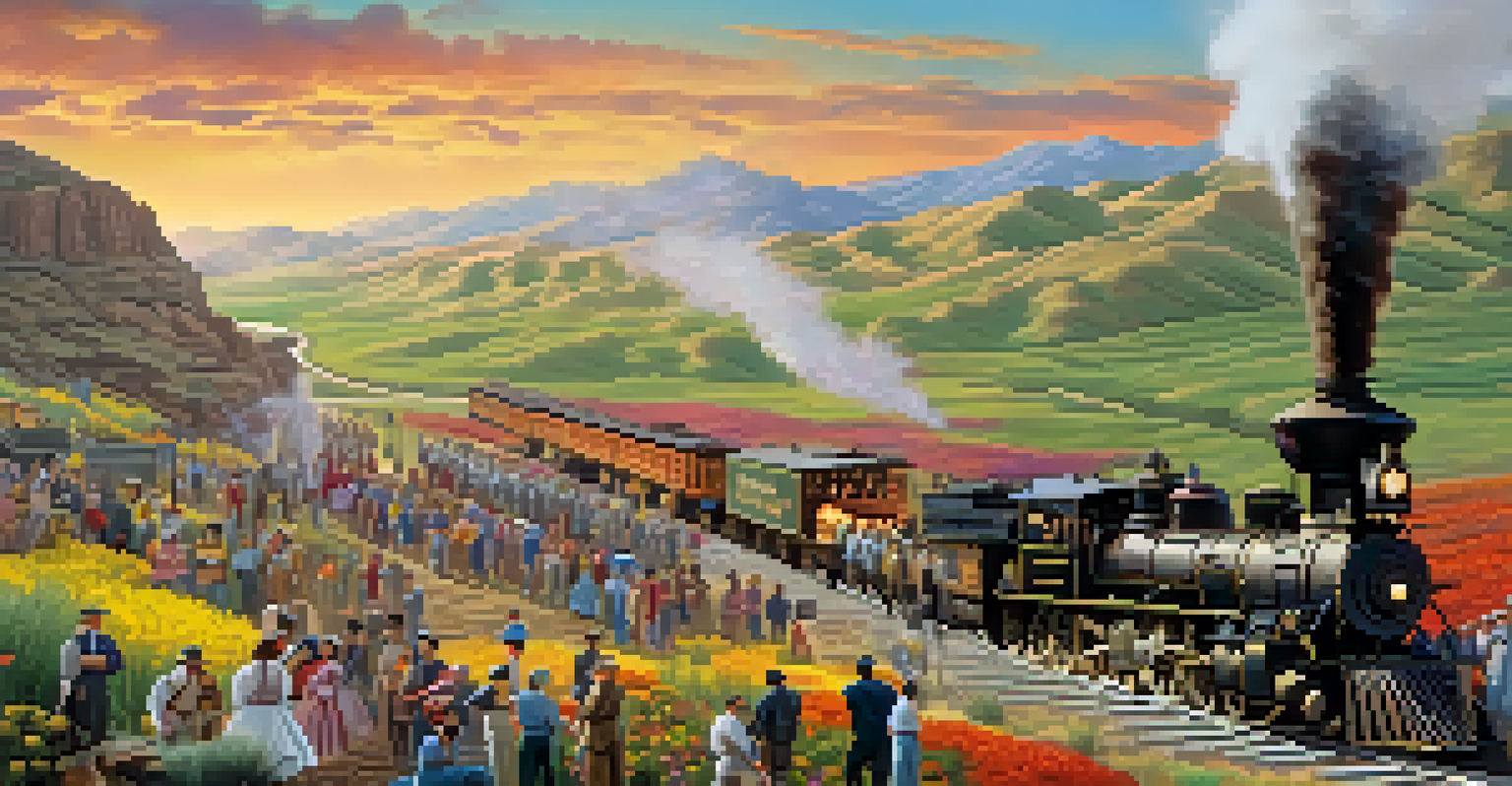Exploring the Legacy of the Central Pacific Railroad

The Birth of the Central Pacific Railroad
The Central Pacific Railroad was founded in 1861, marking a pivotal moment in American history. It was established to connect the East and West coasts, a vision that seemed almost impossible at the time. With the promise of untapped resources and new markets, this ambitious project attracted investors and laborers alike.
The road to success is dotted with many tempting parking spaces.
The initial construction challenges were immense, from navigating the Sierra Nevada mountains to dealing with harsh weather conditions. Yet, the determination of workers, including many Chinese immigrants, helped lay the tracks that would change the nation. Their hard work and resilience became a cornerstone of this monumental endeavor.
By 1869, the Central Pacific Railroad joined forces with the Union Pacific Railroad, completing the first transcontinental railroad. This achievement not only revolutionized transportation but also reshaped the economic landscape of America, making it easier to move goods and people across vast distances.
Innovations in Engineering and Technology
The construction of the Central Pacific Railroad was a marvel of engineering, showcasing innovations that were groundbreaking for its time. The use of dynamite to blast through mountain ranges and the development of specialized railcars were just a few examples of the technological advancements that emerged. These innovations paved the way for future infrastructure projects across the country.

One notable engineering feat was the construction of the Summit Tunnel, which took over two years to complete. Workers dug through solid rock, facing perilous conditions, yet their perseverance led to the creation of a tunnel that remains a testament to their ingenuity. This tunnel not only facilitated railway travel but also symbolized the spirit of determination that characterized the entire project.
Engineering Marvels Transformed Travel
The Central Pacific Railroad showcased groundbreaking engineering innovations, such as the use of dynamite and the construction of the Summit Tunnel, revolutionizing transportation across America.
The railroad also introduced standardized time zones, a necessity for coordinating train schedules across the vast network. Before this innovation, time was kept differently in various regions, leading to confusion. The establishment of time zones helped streamline operations and had a lasting impact on how we organize time today.
The Role of Labor: Triumphs and Challenges
The Central Pacific Railroad relied heavily on immigrant labor, particularly Chinese workers, who faced both significant contributions and harsh discrimination. These workers were crucial in overcoming the geographical challenges of the Sierra Nevada, often working in dangerous conditions with little recognition. Despite this, their impact on the railroad's success is undeniable.
The greatest danger in times of turbulence is not the turbulence; it is to act with yesterday's logic.
The story of these laborers is one of resilience; many left their homes in search of better opportunities. They not only played a vital role in constructing the railroad but also laid the groundwork for future generations. Their legacy is evident in the diverse fabric of American society, showcasing the contributions of all who helped build the nation.
Yet, the challenges they faced were immense, including low wages and a lack of safety regulations. The struggles of these workers remind us of the complexities of progress and the human cost behind monumental achievements. It's essential to honor their contributions while acknowledging the hardships they endured.
Economic Impact and Growth Opportunities
The completion of the Central Pacific Railroad had a transformative effect on the American economy, facilitating trade and commerce like never before. It opened up vast areas of the West to settlers and businesses, leading to the rapid growth of towns and cities along the route. This economic boom contributed significantly to the development of the United States as an industrial power.
With the ability to transport goods quickly and efficiently, farmers and manufacturers found new markets for their products. The railroad played a crucial role in connecting raw materials from the West to factories in the East, fostering a cycle of growth that propelled the nation forward. This interconnectedness allowed for a more dynamic economy, benefiting many.
Immigrant Labor Shaped the Railroad
Chinese immigrant workers played a crucial role in building the Central Pacific Railroad, overcoming significant challenges while facing discrimination and low wages.
Moreover, the railroad also stimulated the tourism industry, as people could now explore the breathtaking landscapes of the West. The allure of the American frontier became more accessible, encouraging individuals and families to embark on adventures. This newfound mobility has profoundly shaped American culture and identity.
Cultural Changes and the American Identity
The Central Pacific Railroad not only transformed the economy but also had a lasting impact on American culture and identity. It symbolized the spirit of exploration and adventure that characterized the American ethos during the 19th century. The railroad helped weave together diverse communities, fostering a sense of unity across vast distances.
As trains traveled through picturesque landscapes, they became a vehicle for storytelling, inspiration, and creativity. Literature, art, and music were influenced by the imagery of the railroad, capturing the imagination of the public. This cultural shift encouraged a celebration of the American landscape and the idea of progress.
Furthermore, the railroad contributed to the mythos of the American Dream, as it represented the possibilities of prosperity and success. The ability to travel, explore, and seek new opportunities resonated with many, shaping perceptions of what it meant to be American. This legacy continues to inspire hope and ambition in people today.
Environmental Considerations and Consequences
While the Central Pacific Railroad brought numerous benefits, it also had significant environmental consequences that we must acknowledge. The construction and operation of the railroad altered landscapes and ecosystems, with areas of natural beauty transformed to accommodate tracks and settlements. This disruption raised important questions about the balance between progress and preservation.
The introduction of railroads facilitated the exploitation of natural resources, leading to deforestation and changes in wildlife habitats. The demand for timber, minerals, and agricultural land increased dramatically, often at the expense of the environment. Understanding these consequences is crucial as we navigate contemporary discussions on sustainability and responsible development.
Economic Growth Redefined America
The completion of the Central Pacific Railroad opened new markets and facilitated trade, significantly contributing to America's transformation into an industrial power.
Today, the legacy of the Central Pacific Railroad prompts us to reflect on our relationship with nature and the impact of infrastructure projects. As we honor the achievements of the past, we must also consider how we can create a sustainable future that respects both progress and the environment. This dialogue is essential in shaping policies that protect our planet.
Modern Reflections on the Railroad's Legacy
The Central Pacific Railroad's legacy can still be felt today, as it laid the groundwork for the extensive railway systems that connect America. Modern railroads continue to play a vital role in transportation, commerce, and even environmental sustainability. The lessons learned from its construction inform current infrastructure projects, emphasizing the importance of planning, safety, and inclusivity.
Various preservation efforts celebrate the history of the Central Pacific Railroad, including museums and historical sites that educate the public about this significant achievement. These initiatives help keep the story alive, ensuring that future generations understand the complexities and triumphs of this monumental project. They also highlight the importance of recognizing diverse contributions to our shared history.

Reflecting on this legacy encourages us to appreciate the interconnectedness of our communities, economies, and environments. As we move forward, we can draw inspiration from the past while striving to create a more equitable and sustainable future. The journey of the Central Pacific Railroad reminds us that progress is a multifaceted endeavor, shaped by the contributions of many.